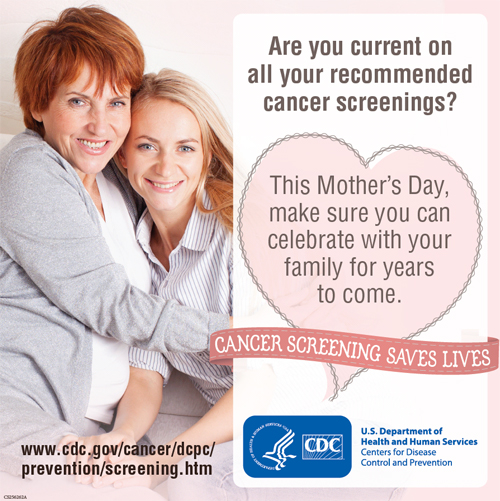Many people are not getting the recommended cancer screening tests
Cancer screening tests save lives, but test use falls short of nation’s goals
Press Release
Embargoed Until: Thursday, May 5, 2015, 1:00 p.m. ET
Contact: Media Relations
(404) 639-3286

Are you current on all your recommended cancer screenings?
This Mother’s Day, make sure you can celebrate with your family for years to come.
Cancer screening saves lives.
Cancer Screening Tests
Many adults in the U.S. are not getting the recommended screening tests for colorectal, breast and cervical cancers, according to data published in the Centers for Disease Control and Prevention’s (CDC) Morbidity and Mortality Weekly Report. For 2013, screening for these types of cancers either fell behind previous rates or showed no improvement.
Among adults in the age groups recommended for screening, about 1 in 5 women reported not being up-to-date with cervical cancer screening, about 1 in 4 women reported not being up-to-date with breast cancer screening, and about 2 in 5 adults reported not being up-to-date with colorectal cancer screening.
The report found that colorectal cancer testing was essentially unchanged in 2013 compared with 2010. Pap test use in women age 21-65 years was lower than 2000, and the number of mammography screenings was stagnant, showing very little change from previous years.
“It is concerning to see a stall in colorectal cancer screening rates,” said Lisa C. Richardson, M.D., M.P.H., director of CDC’s Division of Cancer Prevention and Control. “We must find new ways to make people and providers aware that getting tested for colorectal cancer could prevent cancer and save their lives.”
Researchers reviewed data from the National Health Interview Survey 2013, which is used to monitor progress toward Healthy People 2020 goals for cancer screening based on the most recent U.S. Preventive Services Task Force guidelines.
The screening data for 2013 show that 58.2 percent of adults age 50-75 years reported being screened for colorectal cancer; 72.6 percent of women age 50-74 had a mammogram; and 80.7 percent of women age 21-65 had a Pap test. All of these percentages are below the Healthy People 2020 targets.
The report found that adults without insurance or a usual source of healthcare generally had the lowest screening test use. For example, fewer than one quarter of adults in these groups reported recent colorectal cancer screening, compared with more than 60 percent of adults with private insurance or a usual source of healthcare. More efforts are needed to achieve cancer screening goals and reduce screening disparities.
The authors did report some good news: the proportion of women in the highest education and income groups who were screened for breast cancer exceeded the Healthy People 2020 target, and the proportion of people age 65-75 who were screened for colorectal cancer was also near the target.
Through the Affordable Care Act, more Americans will qualify to get health care coverage that fits their needs and budget, including important preventive services such as screening for some cancers that may be covered with no additional costs. Visit Healthcare.gov or call 1-800-318-2596 (TTY/TDD 1-855-889-4325) to learn more.
CDC’s Efforts to Increase Cancer Screening
The Colorectal Cancer Control Program provides funding to 25 states and 4 tribes across the U.S. The program supports population-based screening efforts and provides colorectal cancer screening services to low-income men and women age 50–64 years who are underinsured or uninsured for screening, when no other insurance is available
The Screen for Life: National Colorectal Cancer Action Campaign informs men and women aged 50 years and older about the importance of having regular colorectal cancer screening tests.
CDC has a new free continuing medical education program for clinicians about colorectal cancer screening at http://www.cdc.gov/cancer/colorectal/quality/.
The National Breast and Cervical Cancer Early Detection Program provides access to breast and cervical cancer screening services to underserved women in all 50 states, the District of Columbia, 5 U.S. territories, and 11 tribes.
The full report, “Cancer Screening Test Use – United States, 2013,” can be found at www.cdc.gov/mmwr. For more information about CDC’s efforts in cancer prevention and control, visit www.cdc.gov/cancer.